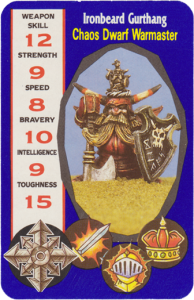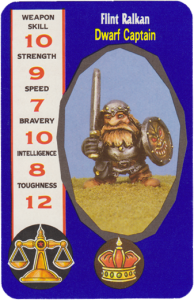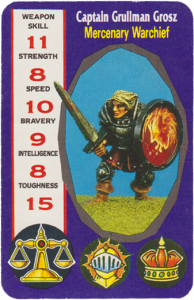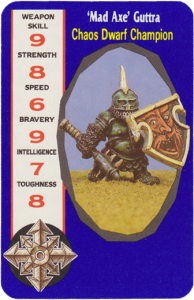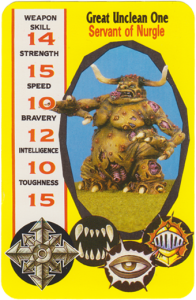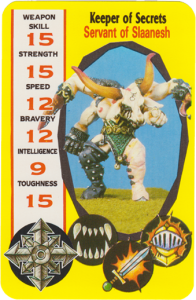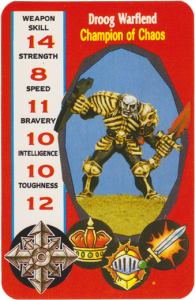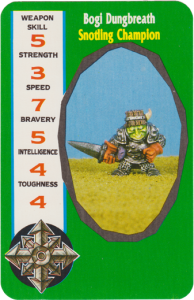Archive for the ‘Miniatures’ Category
Strip-show Part One: Everything You Always Wanted to Know about Stripping Miniatures but Were Afraid to Ask
September 27, 2012I may only be a competent painter, but a few years of buying used miniatures on eBay (as well as reclaiming some golden oldies from my own collection) has made me an expert stripper (of miniatures – my burlesque skills leave much to be desired). Since I’ve been meaning to write more about miniatures, and I just finished cleaning up a batch of old lead, I thought I would share my wisdom (if by ‘wisdom’ I mean ‘trial and error resulting in stained sinks, melted plastics and burnt fingers’).
Trial and Error
For my earliest attempt at stripping paint, I grabbed the first thing I found in my closet that looked like it would do the trick – furniture stripper. This did the trick alright, and fast, but it also completely melted the little plastic shield and crossbow that was attached to the miniature (a poor veteran of Ruglud’s Armored Orcs). The leftover goop was also problematic since you shouldn’t exactly poor furniture stripper down the drain. Seeing as how many miniatures made after ’89 have plastic parts and bases, furniture stripper (as well as any kind of paint remover or turpentine, since they have the same problem) was out.
A quick perusal of the internet revealed two likely candidates that would remove paint without harming plastics: Dettol and Simple Green. Unfortunately, in Canada Simple Green has only just become available and Dettol is hard to find. In looking for an alternative, I learned that it was these cleaners degreasing properties that made them such effective paint strippers. Around this time I had moved apartments, which meant a whirlwind of cleaning and cleaning products among which I found the ‘Andre the Giant’ of household degreasers – oven cleaner. I figured what the hell, and tried it out on a guinea pig I wouldn’t mind melting (a poorly painted henchman from the Advanced Heroquest boxed set). Lo’ and behold, it stripped the paint without harming or softening the plastic underneath.
In the years that I’ve been using oven cleaner to strip miniatures I’ve found that it has no adverse reaction with hard plastic miniatures (old or new citadel plastics – though I have yet to try it on finecast), shields, limbs, or bases (both black plastic and clear plastic flying bases). I’ve even forgotten batches and left miniatures soaking in oven cleaner for a week with no effect (other than paint removal). Oven cleaner also weakens the bond of super glue, and with a bit of wiggling, most multi-part models can be easily broken down into their parts (a big bonus if you don’t like the pose the previous owner put the figure in). The only thing I haven’t had success stripping with oven cleaner are pre-painted figures like Heroclix and D&D miniatures – it doesn’t harm the figures, but it also doesn’t affect the paint at all (for stripping these kinds of minis stay tuned for Part Two).
I may not convert the Simple Green enthusiasts, but oven cleaner is at least a viable alternative. Here’s how I do it:
Stripping Miniatures with Oven Cleaner
Oven cleaner is a lot safer to handle than something like furniture stripper, but it’s still potentially dangerous and should be treated with care (no matter how much its lemony fresh scent lulls you into complacency).
What You’ll Need: a spray can of oven cleaner (go for the cheap stuff, ‘extra strength’ if possible), a sealable glass jar, rubber gloves, an old toothbrush (you can reuse it for your next batch of minis, but don’t even think of putting that thing near your mouth again), and something pointy (I use a Citadel modelling tool or a toothpick). You are going to want to perform this operation in a well-ventilated space, with a sink you won’t get killed for accidentally staining (like a basement laundry sink).
I know what you’re thinking, ‘gloves are for pussies’ – sure, oven cleaner won’t immediately burn your skin like other paint strippers, but it’s still pretty harsh. Harsh enough that I wouldn’t think of touching it without gloves on, and this is coming from a guy whose parents washed his hands with turpentine when he was a kid.
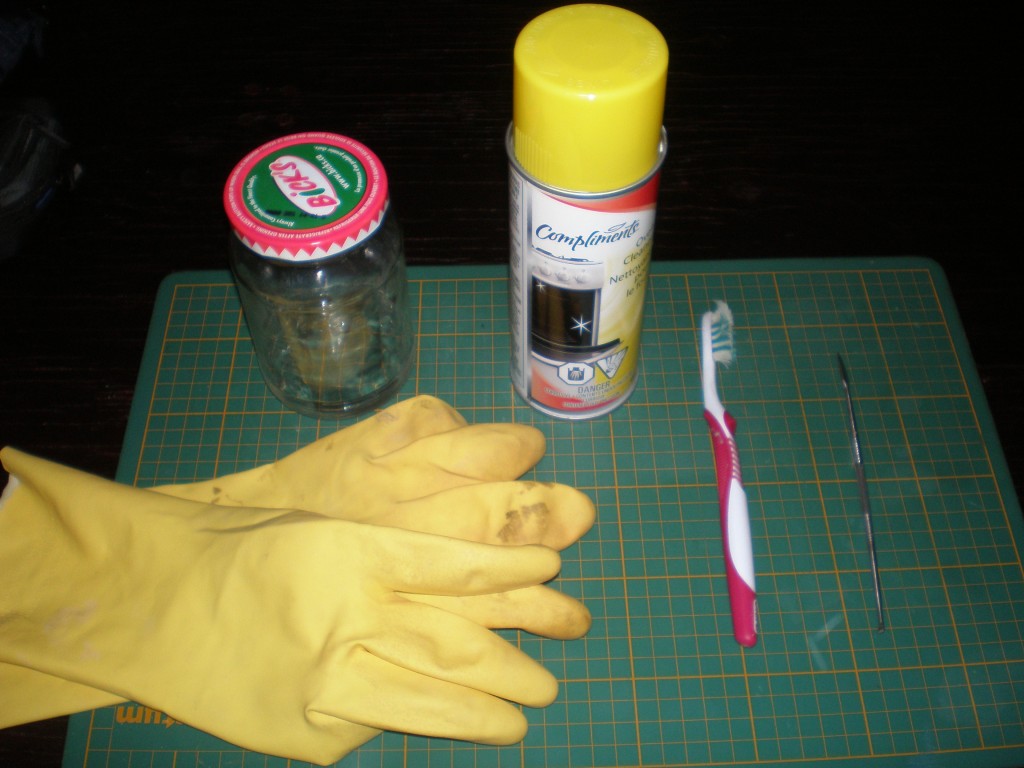
Method: put the miniatures to be stripped in your jar (I usually do 4-6 at a time, but any number is good as long as the jar isn’t filled past the halfway point). Don’t worry about removing shields or bases if they are attached to the mini or covered in gunk, the oven cleaner will help to loosen everything up so that after cleaning, your used miniatures will look like they just came out of the blister pack.
Put on your gloves and start spraying oven cleaning foam into the jar, over the miniatures, until the jar is full. Don’t stick your face right over the thing or you’ll get a snootfull of caustic gas – green dragon breath anyone? (I only pass on what my own stupidity has taught me). Seal the lid and wait a few minutes.
The foam should have settled into a sludge at the bottom. Repeat a few times, sealing the jar in between each coating. Don’t worry if that bottom sludge hasn’t completely engulfed the minis – after a few sprays, even the exposed minis should be coated with a layer of the stuff. Seal the jar again and put it away some place kids (if you have any), significant others (if you have any), and clumsy people (you- if you’re like me) won’t knock it down.
Give the miniatures a few days to soak. Put on the gloves, open your jar and remove your miniature, which by now looks like the leavings of a gelatinous cube. Using your old toothbrush, gently scrub the surface of the miniature, trying to get into all the nooks and crannies. Scrub away from yourself and downwards – this will prevent sludge from flying all over you (and your eyes) and bespeckling the wall behind your sink (again lessons learned only through trial and so many errors). If the miniature has a shield or other parts, they usually detach at this point, so be careful not to send them down the drain. Rinse the whole thing in warm water and inspect the mini to make sure you’ve gotten all the paint off. Sometimes you’ll have to go over it again with the toothbrush, sometimes the paint (or a cap of superglue) is stubborn and needs to be scraped a bit with your pointy object (toothpicks are your safest bet). Rinse again and leave it on a sheet of paper towel to dry.
When you are done, rinse out your jar of any remaining goop, being careful it doesn’t contain any small pieces (like crossbows and shields) that detached during the soaking. Even if you’re using a laundry sink you should also rinse it out afterwards, otherwise detached paint particles have a habit of sticking to the sides and are a pain to get rid of once the dry on.
Voila – you’d never know that batch of minis you got off eBay once looked like the product of a fresco ruining grandmother (listed as ‘pro painted’ of course). In part two I’ll tackle removing the paint from pre-painted miniatures (which also sometimes look like they were painted by the previously mentioned grandmother).
More Citadel Combat Cards
April 4, 2012Last May I wrote about my love of the golden age of Citadel miniatures (the ‘slotta’ era – late eighties and early nineties), inspired by Ben of Darkly Through Glass’ fantastic collection of scanned Citadel Combat Cards. Although that site is now dormant, Ben is back with a new blog, Fantasy3D, and one of the first things he has done is upload the rest of his combat cards, completing the set (with the Dwarfs and Warriors decks). Seeing all the cards together warms my little lead coveting heart, and having them at my fingertips is an invaluable resource. These cards are a nostalgia trip, painting guide, and collector’s list all rolled into one. Ben’s scans are so immaculate I almost don’t regret losing my well-worn and beat up decks. I recommend downloading them yourself, but here are a few of my favorite dwarves and warriors (click for full size).
When I was younger I had a bit of an obsession with the realm of chaos line, so it’s hardly surprising that I have a soft spot for the chaos dwarves as well. I should have bought these when I was a teenager. These two are from the iconic Chaos Dwarf Renegades boxed set (featuring an equally iconic John Blanche painting), which, if it does come up on ebay, is insanely expensive, so I doubt I’ll be adding them to my collection anytime soon. I can’t really argue, but I blame the high demand on the lame redesign Games Workshop did on their newer Chaos Dwarves (the ones with the silly hats as tall as their bodies).
One of my favorite features of the painting style of this era are the cool, freeform designs that took advantage of Citadel’s trademark plastic shields. It really makes each model stand out, and emphasizes a ‘lived-in’ implied setting where soldiers recycle equipment from fallen foes (kind of like D&D). Although I never had the mini, Flint inspired my friend’s character ‘Ralkan the Mighty’ in the first campaign I DMed.

There are some miniatures you track down just to have in your collection and there are others you want so you can build a D&D character around them. This is one of the latter. Despite being from a boxed set, the Heroic Fighters of the Known World (also John Blanche illustrated) are far easier to come by than the Chaos Dwarves. I was able to pick up Giovanni cheaply last year and I’ve been itching to play the mighty thewed gladiator ever since.
So often when I’m browsing through my collection I find myself wanting to make characters for the miniatures, instead of looking for a miniature that suits a character. If there is any reason to call this period Citadel’s golden age, this is it.
Citadel Combat Cards and the Golden Age of Miniatures
May 31, 2011Monster miniatures are one of those subjects that I‘ve been meaning to write about for a while, but much like my painting schedule (I think I just might be the world’s slowest painter), I haven’t gotten around to it (until now). I really got into miniatures around the same time that I graduated from playing a henchman in my older brothers’ D&D games and started running games for my friends. So owning and painting minis will always be intertwined in my mind with the idea of being a dungeonmaster. Coincidentally, this is also when Citadel adopted the ‘slotted base’ and moved from a pure 25mm scale to the larger 28mm size (both changes which today are industry standards).
I’m not sure what it was about those early miniatures that clicked so deeply with me. Maybe it was the John Blanche and Ian Miller artwork which Fighting Fantasy books had already planted in my mind. Maybe it was the way Citadel was changing miniature design. Everyone’s opinion on the ‘golden age’ of anything is subjective, but for me this was the golden age of miniatures. I know objectively that sculpting techniques and advances in materials have made unquestionably better miniatures over the years, but much like the first James Bond movie that you see indelibly marks you with an opinion on the ‘best Bond’, nothing will replace those Citadel miniatures from the late 80’s and early 90’s for me (yes, I even like ‘beaky’ space marines).
Whenever I had the money, I would pick up a blister pack, or split one with my friends (minis were a lot cheaper back then – if I were a kid now I don’t think getting into miniatures on my family’s budget would be possible). I started collecting White Dwarf magazine, even though at that time it covered only Games Workshop games. I poured over the painting and modelling advice and the ‘eavy metal section of photographed miniatures (the artwork kicked ass too). For Christmas one year I got a copy of Advanced Heroquest, and my friends and I played the hell out of it (I still have many of those plastic skaven); I played a little epic scale Warhammer 40,000, but I wouldn’t have even known those games existed if it hadn’t been for White Dwarf.
Somewhere in that mix I came across Citadel Combat Cards. As a game, there really wasn’t much to the cards. They were basically another version of war, or top trumps – if you were bored they were good to kill a half an hour with your little brother but that was about it. But the pictures on the cards were the main attraction. They featured photos of the ‘greatest hits’ of the citadel miniatures line. Like ‘eavy metal in White Dwarf, the pictures on these cards opened my eyes to the potential miniatures held – they could be works of art in themselves and the choices you made as a painter could completely alter the personality of the finished product. They also became something of a wishlist for miniatures I wanted to own. Even now, when I have far too much unpainted lead (enough to enrage my partner), if I see one these miniatures listed on ebay, it’s hard not to scream “It must be mine!”
Now I lost my collection (Chaos, Dwarf, Goblinoid, Monster and Warrior) of Combat Cards years ago, and since then I’ve been looking for a scan of them on the internet (they are long out of print and far too expensive to pick up on resale). Enter Ben from the blog Darkly Through Glass to answer my muttered oaths. Besides being a nice guy, he’s also been scanning his (amazingly pristine) sets of Combat Cards and posting the digital copies for the benefit of nostalgia obsessed souls like me (his download page is here).
I have a pretty good memory of the cards, but actually being able to flip through them once again really took me back (and more importantly made me vow to pick up my brush more often). You should check them out for yourself, but here are a few of my favourites (click for full size):
Ah, the unholy quartet of Chaos. In high school I was absolutely obsessed with the Realm of Chaos stuff, especially the art of Ian Miller who I desperately tried to emulate (ripe fodder for another post). I’ve also always wanted a complete set of the 4 greater daemons. It’s only taken me two decades but I’ve only got one more to go – for some reason old-style bloodthirsters are in much higher demand than the others (and a little out of the reasonable price range).
More Chaos. Many years ago, without knowing the Combat Card connection, Sathash was the first miniature my partner ever got for me (is there a better sign of true love?). I stole the look of Stugen and Droog in their bone armour for my depiction of Hedrack when I ran the Temple of Elemental Evil (and its 3rd edition sequel Return to the Temple of Elemental Evil).
Finally, I’m pretty sure that Snoti and Bogi here are the reason for my love of annoying little goblinoids and imps (probably the Wormy comic as well) to torment my players with (as helpers, enemy familiars, messengers, even a loan officer in Planescape).
Update
Ben has moved to a new blog, Fantasy3D and has completed the scans of all the original Citadel Combat Card decks, which can be found on his download page here.

